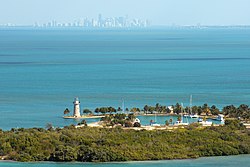Boca Chita Key Historic District
|
Boca Chita Key Historic District
|
|

Boca Chita Historic District with Miami skyline in background
|
|
| Location |
Miami-Dade County, Florida, United States |
|---|---|
| Nearest city | Homestead |
| Coordinates | 25°31′23″N 80°10′29″W / 25.523099°N 80.174639°WCoordinates: 25°31′23″N 80°10′29″W / 25.523099°N 80.174639°W |
| Area | 110 acres (0.45 km2) |
| NRHP Reference # | 97000795 |
| Added to NRHP | August 1, 1997 |
The Boca Chita Key Historic District is a U.S. historic district with in the Biscayne National Park in Miami-Dade County, Homestead, Florida. Located on the northwest section of Boca Chita Key, delimited by Biscayne Bay in the north and west and a half ruined stone wall on its southern side, it contains three historic buildings and the Boca Chita Lighthouse. On 1 August 1997, it was listed in the National Register of Historic Places for its architectural, historical and recreational values.
Boca Chita Key Historic District covers an area of 110 acres (45 ha) within the larger Biscayne National Park of 180,000 acres (73,000 ha) area. It is bounded on the southern and western border by the Biscayne Bay and the remnant of a stone wall.
Mark C. Honeywell, a wealthy industrialist and his wife who owned the island off their house in the Miami beach, built the structures as part of his development plan after he bought the island in 1937, and built up the structures between 1937 and 1940.; however, the building built between 1937 and 1939 do not exist now. The Honeywells built it as their holiday resort. They built many structures which included a chapel, a lighthouse, a pavilion for holding picnic, a generator room, and also a garage. An arch bridge was also built across an existing canal. The August Geiger Firm were the architects and builders of the structures, which were built in modern architectural style with use of limestone, concrete and asphalt. The retreat was a popular venue for holding parties when Honeywells and their guests crossed over to the island from the Miami beach in luxury vessels. On such occasions, a canon located near the lighthouse on the harbour was fired as a welcome gesture to the guests.
After his wife's death, Honewell's interest in the island waned. He got married again to Eugenia Hubbard and then sold the island to Florence Emerman in 1942.
The structures were built with Miami oolite limestone, and even in the existing structures the external faces have a quarry finish, typical of the area.
...
Wikipedia


